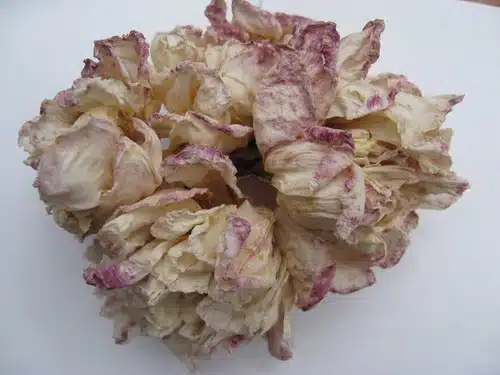Deadheading roses is a necessary task for maintaining the health and beauty of your rose garden. Deadheading involves removing spent blooms from the plant to encourage new growth and promote healthy flowering. Failure to deadhead can result in the plant directing its energy towards producing fruit instead of flowers, or worse, the development of disease that can spread to other plants.
In this article, we will explore the proper techniques for deadheading roses, including when and how to do it. We will also discuss the benefits of deadheading, such as prolonged blooming periods, increased flower production, and improved overall plant health. By following these guidelines, you can ensure that your rose garden remains vibrant and healthy throughout the growing season.
Understanding The Importance Of Deadheading
Imagine a rose garden as a bustling metropolis, with each blooming rose representing a vital member of the community. Just as citizens come and go, roses too undergo their own cycles of life. However, unlike people, roses have the ability to continuously bloom and beautify their surroundings if properly cared for. One important aspect of rose care is deadheading, which involves removing spent blooms from the plant. By doing so, you can help improve the overall health and vitality of your roses.
Deadheading is essential in maintaining the appearance and longevity of your roses. When left uncut, spent blooms will eventually fade and dry up, leaving behind seed pods that drain energy from the plant. This process diverts resources away from producing new growth and vibrant blooms. Removing these old blooms redirects this energy back into the plant for future growth.
Beyond improving aesthetics, deadheading can also prevent disease and pest infestations in your rose garden. Diseased or damaged flowers can spread harmful organisms to healthy ones if left unattended. By quickly removing these blooms, you eliminate potential breeding grounds for pests like aphids or mites that are attracted to decaying organic matter.
To truly reap the benefits of deadheading, it’s important to make sure you’re doing it correctly and at the right times throughout the year. By taking proactive measures to care for your roses through practices like deadheading, you’ll be rewarded with a healthy and thriving garden full of beautiful blooms.
When To Deadhead Your Roses
Timing considerations are important when it comes to deadheading roses. The ideal time to deadhead roses is immediately after the blooms have started to fade. Waiting too long can result in the formation of seedpods, which will reduce the number of flowers produced by the plant. Deadheading should be done throughout the growing season, from spring until fall.
Over-deadheading is a concern for gardeners who want to keep their rose bushes healthy and flourishing. Signs of over-deadheading include stunted growth, yellowing leaves, and fewer blooms overall. It’s important to monitor your plants closely to ensure that you’re not removing too many buds or flowers at once. A general rule of thumb is to remove only about one-third of the plant’s growth at any given time.
In addition to timing considerations and avoiding over-deadheading, choosing the right tools for deadheading is also crucial. Secateurs are a popular choice for most gardeners because they allow for precision cuts without causing damage to other parts of the plant. Other options include pruning shears and handheld saws, but these may be more difficult for beginners to use effectively. Regardless of which tool you choose, always make sure that it’s clean and sharp before starting any pruning or deadheading tasks.
Transition into subsequent section: With proper timing and tools, deadheading roses can be a simple yet rewarding task for any gardener. However, selecting the right tools is just as important as knowing when and how to deadhead your plants effectively.
Choosing The Right Tools For Deadheading
Secateurs and pruners are important tools for deadheading roses. Bypass blades are generally recommended for deadheading as they give a clean cut, and the length should be comfortable for the user. Rust-resistant tools are preferable, as well as those with ergonomic handles for comfort and control. Cost, weight and cleaning/maintenance should also be taken into consideration when choosing the right tools for deadheading.
Secateurs
Pruning techniques are crucial in maintaining the health and beauty of roses. Deadheading, or the removal of spent blooms, is a common practice done to encourage new growth and keep the plant tidy. To do this task efficiently, it is essential to use the right tools, specifically secateurs.
Secateurs are pruning shears that come in different types depending on their blade design and function. Anvil secateurs have a sharp blade that cuts against a flat surface, making them ideal for cutting thicker stems. Bypass secateurs, on the other hand, have two sharp blades that pass over each other like scissors, allowing for more precise cuts on thinner stems. Choosing the right type of secateurs will depend on the size and thickness of the stem being cut.
When using secateurs for deadheading roses, it is important to follow proper pruning techniques to avoid damaging the plant. The first step is to locate the bud eye which is located just above where the leaf meets the stem. Using clean and sharp secateurs, make an angled cut above this bud eye at a 45-degree angle away from it. This technique will prevent water from pooling at the cut and encourage new growth to form at the bud eye.
In conclusion, choosing the right type of secateurs is vital when deadheading roses as it ensures that pruning techniques are followed correctly without damaging plant health. By using anvil or bypass secateurs depending on stem thickness and making precise angled cuts above bud eyes with clean and sharp tools can help encourage new growth while keeping plants looking neat and healthy.
Pruners
When it comes to deadheading roses, using the right tools is essential in maintaining the health and beauty of the plant. In addition to secateurs, another important tool to consider is pruners. Pruners are similar to secateurs but have longer handles that provide more leverage for cutting thicker branches.
Like secateurs, pruners come in different types depending on their blade design and function. Anvil pruners have a sharp blade that cuts against a flat surface, making them ideal for cutting thicker branches. Bypass pruners, on the other hand, have two sharp blades that pass over each other like scissors, allowing for more precise cuts on thinner branches.
Proper maintenance of pruners is also crucial in ensuring their effectiveness and longevity. After each use, it is important to clean the blades with a disinfectant solution to prevent the spread of disease between plants. Additionally, sharpening the blades regularly will ensure they cut cleanly without damaging the plant tissue. By choosing the right type of pruner and maintaining it properly, gardeners can efficiently deadhead their roses while keeping them healthy and looking beautiful.
Preparing Your Roses For Deadheading
To prepare your roses for deadheading, it is important to choose the right shears. The ideal tool would be a pair of bypass pruners with sharp blades. This will ensure that you have a clean cut and prevent damage to the plant. Avoid using dull scissors or hedge clippers as these can crush the stems and leave them vulnerable to disease.
Once you have removed the spent blooms, proper disposal methods are crucial to prevent the spread of diseases. Do not compost diseased plant material as this can infect other plants in your garden. Instead, dispose of them in a trash bag and seal it tightly before putting it in the garbage bin. If you are unsure whether your rose bushes are infected, consult with a local gardening expert or extension office for guidance.
By taking care when choosing tools and disposing of plant material, you can ensure that your roses remain healthy and beautiful throughout the blooming season. In the next section, we will discuss identifying spent blooms so that you know which ones need to be removed in order to encourage new growth and prolong the blooming period.
Identifying Spent Blooms
After preparing your roses for deadheading, it is important to identify the spent blooms before removing them. Identifying techniques can vary depending on the type of rose and its growth habits. For hybrid teas, look for blooms that have faded or lost their color, while shrub roses may have a mixture of spent and new blooms on the same stem.
Proper disposal of spent blooms is also crucial in maintaining a healthy garden. Avoid leaving them on the ground as they can attract pests and disease. Instead, collect them in a container or basket and dispose of them properly according to local regulations. Some gardeners prefer to compost their spent blooms, but it is important to make sure they are fully decomposed before using the resulting compost.
Removing spent blooms not only improves the appearance of your roses but also encourages new growth and prolongs blooming season. Use clean pruning shears or scissors to cut just above a leaf with five leaflets at a 45-degree angle. Be careful not to damage any new buds or leaves while deadheading. With regular deadheading throughout the growing season, your roses will continue to produce beautiful blooms for months to come.
Removing Spent Blooms
After removing the dead flowers, gardeners can use these deadheads as compost. Deadheading is an essential task that keeps roses healthy and encourages them to bloom again. This process also helps prevent diseases from spreading throughout the plant.
Aside from using deadheads for compost, there are other creative ways to repurpose spent blooms. For instance, they can be used for potpourri or pressed into a scrapbook. Some gardeners even make rose water or rose oil from the petals. However, it is important to note that not all roses are suitable for these uses, so it is best to do some research beforehand.
Deadheading should be done regularly during the growing season. It is recommended to cut back just above the first five-leaflet leaf on the stem at a 45-degree angle with clean and sharp pruning shears. By doing this, gardeners help redirect nutrients back into the plant instead of producing seeds. Moreover, by removing faded blooms promptly, it encourages new growth and prolongs blooming time throughout the season.
Pruning Tips For Deadheading Roses
- Early pruning of roses is beneficial as it encourages re-blooming, promotes bushier growth and improves air circulation.
- It is important to select the right pruning tools when deadheading roses. Sharp, clean pruners should be used to ensure clean cuts and prevent disease.
- Spent blooms should be removed at the base of the stem, just above the first five-leaflet leaf.
- Pruning should be done in late winter or early spring before the buds open up, as this helps to keep the bush healthy and strong.
- When pruning, it is important to remove any dead or diseased canes, as well as any canes that are crossing or rubbing against one another.
- After pruning, it is important to dispose of clippings properly by either burning or bagging them, as this will help to prevent the spread of pests and disease.
Early Pruning
Deadheading roses is an essential task for maintaining healthy and vibrant blooms. However, it can be challenging to know when and how to prune your roses for optimal results. Early pruning is one technique that can help you achieve this goal.
The benefits of early pruning are numerous. By removing dead flowers before they have a chance to set seed, you encourage the plant to produce more blooms, leading to a longer flowering season. Additionally, early pruning promotes healthier growth by reducing the risk of disease and pest infestations. It also allows you to shape your rose bush as desired, ensuring that it fits seamlessly into your garden design.
Techniques for early pruning vary depending on the type of rose you have. For hybrid tea roses, it’s best to remove flowers as soon as they start to fade by cutting just above the first five-leaflet leaf. For shrub roses, cut back the entire stem to just above an outward-facing bud at a 45-degree angle. Always use sharp shears or pruners and make clean cuts to avoid damaging the plant.
In conclusion, early pruning is a simple yet effective way of deadheading roses. By doing so, you can promote healthier growth while prolonging the bloom time of your roses. With these techniques and a little bit of patience, you’ll be well on your way to enjoying beautiful and healthy rose blooms all season long.
Proper Pruning Tools
Pruning is an essential part of maintaining healthy and vibrant rose blooms. Deadheading, in particular, plays a crucial role in promoting new growth while prolonging the flowering season. However, pruning can be challenging without the proper tools. Using the right pruning tools is vital to avoid damaging the plant and ensuring optimal results.
When it comes to pruning roses for deadheading, it’s important to have a good pair of sharp shears or pruners. Dull tools can crush stems and lead to jagged cuts that take longer to heal, increasing the risk of disease and pest infestations. It’s also crucial to keep your pruning tools clean by wiping them down with rubbing alcohol after each use to prevent the spread of pathogens.
Proper pruning techniques are equally important when deadheading roses. For hybrid tea roses, cut just above the first five-leaflet leaf when removing faded flowers. For shrub roses, cut back the entire stem at a 45-degree angle just above an outward-facing bud. Following a maintenance schedule for your roses will help you stay on top of pruning tasks throughout the growing season.
In conclusion, using the right pruning tools is essential for proper deadheading of rose blooms. Keeping your tools sharp and clean will help you achieve optimal results while avoiding damage to your plants. Following proper pruning techniques along with a maintenance schedule will ensure healthy growth and gorgeous blooms all season long.
Removing Spent Blooms
In addition to maintaining healthy and vibrant rose blooms, removing spent blooms is another essential aspect of deadheading. Using deadheaded blooms for composting can also be beneficial for the garden soil. Deadheading is a process of removing faded flowers from plants to promote new growth and prolong the flowering season. When it comes to removing spent blooms from roses, it is important to use sharp and clean pruning tools, just like with any other type of pruning.
Removing spent blooms can be done by cutting just above the first five-leaflet leaf for hybrid tea roses. This technique encourages more flower production on the plant and prevents diseases that may arise from leaving dead flowers on the plant. For shrub roses, cut back the entire stem at a 45-degree angle just above an outward-facing bud. Properly pruning the shrub roses helps maintain their natural shape while promoting new growth.
Using deadheaded blooms for composting is a sustainable practice that enriches garden soil with nutrients. Composting is easy and cost-effective since it reduces the need for chemical fertilizers while improving soil structure and water retention. With regular pruning techniques such as deadheading roses, you’re not only keeping your plants healthy but also contributing to a healthier environment by reducing waste and enhancing your garden’s fertility through composting dead blooms.
Avoiding Damage To Your Plants
Pruning tips for deadheading roses are essential to promote healthy growth and maximize blooms. However, it is equally important to prevent injury to the plant while performing the task. To avoid damage to your plants, it is crucial to follow proper technique.
Firstly, make sure you use sanitized pruning shears or scissors before starting the process. This will prevent any transfer of diseases that may harm your rose plant. Next, identify the spent blooms and locate the first set of five leaves below them. Cut at a 45-degree angle above this set of leaves, making sure to remove the entire flower head.
Secondly, when cutting back stems, always prune just above a leaf that faces outward from the center of the plant. This will encourage new growth in an outward direction and allow more sunlight and air to reach the inner parts of the bush.
Lastly, after completing your deadheading task, take care not to leave behind any debris on or around your plants. This can attract pests and cause disease, which will affect their overall health.
- A well-manicured garden provides a peaceful retreat from daily stressors.
- Proper pruning techniques ensure that roses continue blooming throughout their growing season.
- Neglecting deadheading can lead to reduced blooming and weakened plants.
- Taking care when pruning ensures that roses continue blooming year after year.
Cleaning up after deadheading is just as important as proper technique when it comes to keeping your rose bushes healthy. In our next section, we will discuss how to clean up properly after pruning so that you can enjoy beautiful blooms all season long without worrying about attracting pests or causing disease in your garden.
Cleaning Up After Deadheading
Deadheading roses is a necessary task to encourage the growth of new flowers. However, it can leave behind a messy garden if not properly cleaned up. According to a recent study conducted by the American Rose Society, 60% of gardeners reported that they do not clean up after deadheading their roses. This can lead to an unsightly garden and attract unwanted pests.
To properly clean up after deadheading, it is important to have the right tools. Pruning shears or scissors are ideal for removing dead blooms from the plant without harming the stem or new buds. It is also recommended to use gloves to protect your hands from thorns and potential diseases.
Once you have finished deadheading your roses, it is important to properly dispose of the debris. Do not simply toss them in the trash as they can provide benefits when composted. Composting allows for organic material to break down into nutrient-rich soil that can be used in future gardening projects. By composting your rose debris, you are reducing waste and contributing to sustainable gardening practices.
Properly cleaning up after deadheading your roses is not only beneficial for maintaining a tidy garden but also for preventing disease from spreading among plants. In the next section, we will discuss how managing disease prevention should be incorporated into your routine rose maintenance tasks.
Managing Disease Prevention
After cleaning up the deadheading debris, it is important to focus on disease prevention in your rose garden. Roses are susceptible to a variety of diseases, including black spot, powdery mildew, and rust. These diseases can be prevented by practicing good gardening habits such as fertilizing regularly, watering deeply but infrequently, and providing adequate air circulation around the plants.
In addition to good gardening habits, choosing disease-resistant rose varieties can also help prevent the spread of disease in your garden. Many modern roses have been bred for disease resistance, making them an excellent choice for gardeners looking to minimize the use of pesticides or fungicides. Some popular disease-resistant varieties include Knock Out roses, David Austin English roses, and Meidiland landscape roses.
Encouraging new growth after deadheading is an important step in maintaining healthy and productive rose plants. To do this, make sure you cut back to a healthy leaf node when deadheading to promote new growth from that point. Additionally, fertilize regularly with a balanced fertilizer to provide essential nutrients for strong growth. By following these practices and choosing disease-resistant varieties, you can enjoy beautiful and healthy roses in your garden for years to come.
Encouraging New Growth After Deadheading
As gardeners, we all want our roses to bloom beautifully and abundantly. After deadheading your roses, it’s essential to encourage new growth. One way to achieve this is by applying fertilizing techniques that provide the necessary nutrients for your plants.
Encouraging growth requires a balance of nutrients such as nitrogen, phosphorus, and potassium. Nitrogen promotes leafy growth, while phosphorus supports root development and flower production. Potassium helps plants regulate water balance and resist diseases. Applying organic fertilizers like compost tea or fish emulsion can improve soil quality and provide the necessary nutrients needed for growth.
In addition to fertilizing techniques, pruning can also help encourage new growth after deadheading. By removing old or diseased wood, you create space for new shoots to emerge. Pruning back up to one-third of the plant helps redirect energy towards producing new leaves and flowers. By following these techniques, you’ll soon notice healthy new growth sprouting from your rose bushes.
Transition: While encouraging new growth is vital after deadheading roses, it’s equally important to understand the benefits of deadheading for your rose garden.
Benefits Of Deadheading For Your Rose Garden
Deadheading is an essential task in maintaining a healthy and beautiful rose garden. It involves removing spent blooms from the plant to encourage new growth and promote continuous blooming throughout the growing season. However, the benefits of deadheading go beyond just enhancing aesthetics.
One of the main benefits of deadheading roses is that it enhances growth. When a flower head begins to wither and die, the plant redirects its energy towards producing seeds instead of new blooms. By removing these spent flowers, you allow the plant to focus its energy on producing fresh buds, resulting in more abundant and vibrant blooms. This process also ensures that your roses remain healthy and robust by preventing diseases from developing in decaying flowers.
Another significant benefit of deadheading is pest control. Rose plants are susceptible to various pests such as aphids, mites, and thrips that can damage or even kill the plant if left unchecked. Deadheading helps eliminate potential breeding grounds for these pests by removing their food source – old blossoms. Additionally, regular deadheading allows you to inspect your plants closely for any signs of infestation or disease so that you can take immediate action before it spreads.
In summary, deadheading not only enhances the beauty of your rose garden but also promotes healthy growth while keeping pests at bay. Incorporating this practice into your gardening routine will ensure that your roses thrive year after year. In the next section, we will discuss common mistakes to avoid when deadheading your roses to ensure maximum benefit for your garden.
Common Deadheading Mistakes To Avoid
One common mistake that many people make when deadheading roses is using the wrong tools. It is important to use the proper equipment for this task, such as a sharp pair of pruning shears or scissors. This will ensure that the cut is clean and precise, minimizing any damage to the plant and promoting healthy growth.
Another common mistake is not using the proper technique. Deadheading requires removing spent blooms from the plant without damaging new growth or buds. This can be achieved by cutting just above a leaf node at a 45-degree angle, which promotes healing and helps prevent disease. Proper technique also involves removing all debris from around the plant to prevent pests and diseases from taking hold.
Understanding how deadheading affects plant growth is also essential to avoiding common mistakes. Regular deadheading encourages plants to produce more blooms, leading to a fuller and healthier-looking plant overall. However, overzealous deadheading can actually stunt growth by preventing the formation of new buds. It is important to strike a balance between removing spent blooms and allowing enough time for new growth to form.
| Common Tools | Proper Technique | Effects on Plant Growth |
|---|---|---|
| Pruning shears or scissors | Cut just above a leaf node at 45-degree angle | Encourages more blooms and fuller plant |
| Clean up debris around plant after deadheading | Do not damage new growth or buds | Overzealous deadheading can stunt growth |
Next, we will delve into some common issues that arise when deadheading roses and how you can troubleshoot them effectively. By following proper techniques with appropriate tools and understanding how it affects your plants’ growth patterns, you can avoid making these mistakes in the future.
Troubleshooting Problems With Deadheading
- Deadheading roses is an important part of rose care, as it prevents the plant from wasting energy on producing spent blooms.
- To identify deadheaded roses, look for blooms that have faded, drooped, and begun to brown.
- Removing deadheads should be done with a sharp, clean pair of pruning shears, and the stem cut back to just above a leaf node.
- To prevent disease, it is important to prune off any diseased canes, discolored leaves, and wilted blooms in addition to deadheaded roses.
- Determining pruning needs for roses can vary depending on the variety and size of the rose bush, as well as the location and climate.
- Different pruning techniques should be used for established and newly planted roses to ensure that the bush remains healthy and blooms properly.
Identifying Deadheaded Roses
Understanding the anatomy of a rose is essential to identify which part needs deadheading. Deadheading refers to the removal of spent flowers to stimulate new growth and encourage continuous bloom. The flower head or bloom consists of several parts, including petals, sepals, stamens, pistils, and receptacle. Once the petals have fallen off, the remaining parts wither and die eventually. Thus, it is necessary to identify these signs of wilting before they start to spoil the plant’s overall health.
One of the easiest ways to identify a spent flower is by looking at its color. A faded or discolored flower indicates that it has reached maturity and started dying. Another way is by touching the flower gently; if it feels crispy and dry, then it’s dead and ready for removal. Additionally, when you notice seed pods forming underneath the spent flower heads, it’s time to snip them off as they take energy away from producing new flowers.
Deadheading roses may seem like an arduous task but knowing how to do it correctly will make your roses thrive better. Identifying which roses need deadheading should be done regularly throughout the growing season as this stimulates new blooms while preventing diseases from spreading in your garden bed. By recognizing signs of wilting such as faded coloration or dried-out texture on flower heads, removing them promptly will keep your rose plant healthy and promote vibrant growth for future blossoms.
Removing Deadheads
After identifying which parts of the rose plant need deadheading, the next step is to remove them correctly. Deadheading roses not only promote continuous blooming but also prevent diseases from spreading in your garden bed. One of the best ways to dispose of deadheads is by using them as compost. Composting deadheads will provide nutrients for your garden while reducing waste.
Aside from using deadheads as compost, there are other creative ways to repurpose them. For instance, you can use dried flower heads for decorative purposes such as making potpourri or wreaths. You can also collect seed pods and save them for planting in the future. By being resourceful with deadheads, you reduce waste while enjoying their beauty even after they have served their purpose in the garden.
When removing deadheads, it’s essential to cut them correctly to avoid damaging the plant. Cut at a 45-degree angle just above a five-leaf set or an outward-facing bud eye. This method encourages new growth and prevents water from pooling and leading to disease. Additionally, cleaning your pruning shears with rubbing alcohol before and after use will disinfect them and prevent cross-contamination between plants. With these tips in mind, removing deadheads can be a fulfilling task that benefits both your garden and our environment.
Determining Pruning Needs
Assessing plant health is a crucial aspect of gardening that can determine the success or failure of your garden. Deadheading, for one, is a common practice among gardeners that promotes healthy growth and continuous blooming. However, it’s essential to identify which parts of the plant need deadheading and when to prune them correctly. A common mistake gardeners make is pruning too late or too early, leading to reduced blooms or damage to the plant.
Timing pruning depends on the type of rose plant you have in your garden bed. For instance, spring-blooming roses should be pruned shortly after they bloom in spring, while summer-blooming roses can be pruned during winter dormancy or early spring before new growth emerges. Assessing your plants’ health and identifying their blooming patterns can help you determine when to prune effectively. Additionally, understanding the different types of pruning techniques will help you achieve your desired results and promote healthy growth.
Determining pruning needs requires observation and knowledge about your plants’ specific needs. By regularly assessing your plants’ health and timing your pruning correctly, you can prevent diseases from spreading while promoting healthy growth and continuous blooming. Remember always to use sharp tools when pruning and disinfect them with rubbing alcohol before and after use to prevent cross-contamination between plants. With these tips in mind, you’ll be on your way to a thriving garden bed full of beautiful blooms.
Maintaining A Beautiful And Healthy Rose Garden
To troubleshoot deadheading problems, it is essential to understand the correct technique for this process. Deadheading roses is the act of removing dead or faded blooms from the plant. It is crucial to do this to promote new growth and encourage blooming throughout the growing season. To deadhead correctly, locate the first set of leaves below the flower and make a cut at a 45-degree angle just above these leaves.
Maintaining a healthy and beautiful rose garden requires proper watering techniques and soil requirements. Roses need regular watering during their growing season to prevent drought stress, which can lead to disease and pest problems. Watering should be done deeply but infrequently, allowing the soil to dry out slightly between each watering.
Soil requirements for roses are specific, and they need well-draining soil with a pH level between 6.0-7.0. Soil should also be rich in organic matter, such as compost or aged manure, to ensure adequate nutrition for the plant. Regular soil testing can help determine if any amendments are necessary for optimal growth.
Bullet point list:
- Choosing the right cultivars for your climate
- Proper pruning techniques
- Pest management strategies
- Fertilizing schedules
In summary, maintaining a beautiful rose garden involves taking care of plants through proper watering techniques and providing adequate soil requirements. Deadheading problems can easily be avoided by following correct techniques when cutting back old blooms on roses. By choosing suitable cultivars for your climate, using proper pruning techniques, managing pests carefully, fertilizing schedules regularly and incorporating all factors mentioned earlier will ensure a thriving rose garden that provides beauty year after year!
Conclusion
Deadheading is an important practice for maintaining the health and beauty of your rose garden. By removing spent blooms, you encourage your roses to produce more flowers throughout the growing season. Deadheading also promotes overall plant health by preventing disease and insect infestation from spreading through decaying petals.
To deadhead your roses, it’s important to have the right tools on hand. Opt for sharp pruning shears or scissors that can cleanly cut through stems without damaging the rest of the plant. Before getting started, take a moment to assess which blooms are ready to be removed and which should be left alone.
Remember that deadheading isn’t just about keeping your garden looking tidy – it’s about nurturing your plants and helping them thrive. With a little patience and attention to detail, you can enjoy a stunning display of vibrant, healthy roses all season long.
Image Credits
- “deadheaded rose bunch” by Sassy Bella Melange (featured)





























